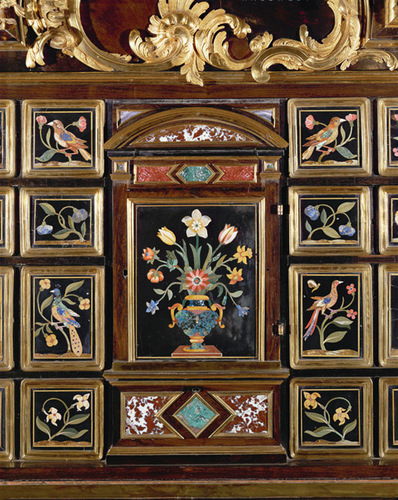

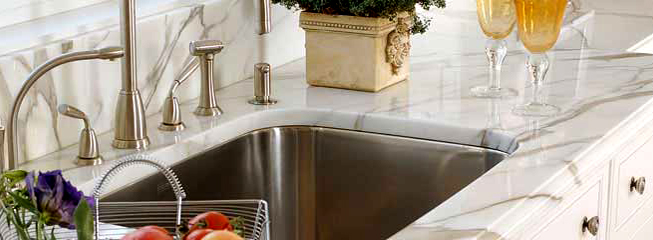
The craft of stonemasonry has existed from civilizations dawn, utilizing natural stone for the creation of building structures as well as fine art.
Stone, which in Hebrew is pronounced ay-ben, and in Greek, lee-thoss, forms in one of three general ways: by the cooling of molten material from the earth's interior (igneous rock e.g. granite, basalt), by the stratification of worn mineral material (sedimentary rock e.g. shale, sandstone), or by rock that has been transformed by great pressure or heat (metamorphic rock e.g. slate, marble). Although stone has no life, it's actually part of the "living" earth, in that stones are formed from natural processes (see The Seven Days Of Creation), and then wear or erode away, releasing the elements to eventually continue the cycle.
Stonemasonry was one of the earliest trades in civilization's history. Mankind originally lived outdoors, when necessary found shelter in caves or built houses of wood, with wood furnishings. In places where suitable building stone was available stone could be utilized. At times even the doors of homes were made of stone, swung on morticed pivots, and were generally fastened by wooden bolts. The ancients relied heavily on the stonemason to build impressive and enduring monuments to their civilizations. The scriptures speak of masons, and the stonecutters. They purchased timber and cut stone for repairing the LORD's Temple, and they paid other expenses related to the Temple's restoration. (2 Kings 12:12) The Egyprians built pyramids, the Persians erected palaces, the Greeks their temples and the Romans their architecture.
The skills of the medieval stonemason were in high demand. Members of the guild gave rise to the classifications of stoneemasons: apprentices, journeymen and master masons. The Renaissance saw stonemasonry return to the prominence and sophistication of the Classical age. The rise of the Humanist philosophy gave people the ambition to create marvellous works of art. The center stage for the Renaissance was Carrara, Italy. City states such as Florence erected magnificent structures, such as the Cathedral of Santa Maria del Fiore, the Fountain of Neptune, and the Laurentian Library which was planned and built by Michelangelo Buonarroti, a famous craftsman of the Renaissance. The Marble Palace referred to as the Architectural Jewel of Saint-Petersburg," is another impressive structure. It is distinguished among St. Petersburg 's masterpieces of architecture not only by its architectural features, the exquisiteness of its exterior and interior decoration.
Pietra dura or pietre dure, called parchin kari in South Asia, is a term for the technique of using cut and fitted, highly-polished colored stones to create what images in stone. It is considered a decorative art. The stonework, after the work is assembled loosely, is glued stone-by-stone to a substrate after having previously been "sliced and cut in different shape sections; and then assembled together so precisely that the contact between each section was practically invisible". Stability was achieved by grooving the undersides of the stones so that they interlocked, rather like a jigsaw puzzle, with everything held tautly in place by an encircling 'frame'. Many different colored stones, particularly marbles, were used, along with semiprecious, and even precious stones. It first appeared in Rome in the 16th century, reaching its full maturity in Florence. Pietra dura items are generally crafted on green, white and black marble color base stones. Typically the resulting panel is completely flat, but some examples where the image is in low relief were made, taking the work more into the area of hardstone carving.
INLAID MARBLE FLOORING
Inlaid stone flooring is flooring with a decorative pattern which is set into its surface. Many inlaid floors are made from wood, with contrasting patterns and ornaments in different types of wood which will show up well against the primary flooring. Stone, tile, metal, and other materials may be used in inlaid flooring as well. Stunning examples of inlaid flooring can be seen in old buildings, although the technique is less common in modern construction since it can get very expensive. Inlaid stone floors are beautiful, especially when well maintained, to retain the quality of their original craftsmanship.
When Europeans settled the Americas, they brought the stonemasonry techniques of their respective homelands with them. The abundance of colors, textures, and natural variations found in stone provide an endless supply of design possibilities. Bringing natural materials into your home provides aesthetic, artistic, and stylistic expression you will long enjoy. Stone is practical, attractive and retains or increases it's value through the years. Today, natural stone such as marble and granite comes from quarries throughout the world. Your choice of a durable stone for your home or business is an investment, that will remain beautiful for years to come.
THE QUARRYING OF YOUR NATURAL STONE
Most architectural stone today is quarried from caverns within the hearts of the mountains, and hillsides of this world. A quarry is a type of open-pit mine from which rock or minerals are extracted. Quarries are generally used for extracting building materials, such as dimension stone. Quarries are usually shallower than other types of open-pit mines. The natural stone is transported in blocks from the quarry by truck to the processing facility where it is sawn into slabs and polished. To obtain granite from a quarry either digging, cutting or blasting process is used. This process of obtaining the stone is called quarrying. Once quarrying is done, the processing of granite starts. The four operations that are involved in the processing of granite are:
- Dressing
- Cutting/ sawing
- Surface grinding and polishing and
- Edge-cutting-trimming
OUR STONE FABRICATION SERVICES
- Our stone fabrication services
can be broken down into 4 basic
categories
- Design Review & Consultation
The client determines the design they would like to have fabricated in stone by looking through decorating magazines, drawings, or architectural renderings. The images which you submit to me are then reviewed.
- The Design Is Determined.
We will review the photographs or drawings which you have chosen. Shop drawings are usually required, just like a blue print is required in the process for the completion of final production in other fields.

- The selection of your materials.
You will select your natural stone, from the stoneyard I recommend, or a choice of your own. Buyers frequently ask if calcereous stones such as marble, limestone, travertine, or onyx are porous, and vulnerable to staining from food spills, or cosmetics. Porosity implies that there is space between the crystal formations in the stone, where water can penetrate. The finish put on stone doesn't affect it's porosity.
All stones are vulnerable to scratching. Most people accept this as part of natural use, or have the polish removed for a natural "honed appearance."
- Slab Fabrication:
When you have chosen the stone material you'd like to have installed in your home or office, the material is obtained and delivered to us where it is fabricated to our custom specifications. The schedule is then determined. As your natural stone fabricator, I will lay out your job in a way that will maximize the natural beauty of the veining pattern. Your custom stone work then goes directly from our facility to your home or business.
- Installation
Once the fabrication of your lovely new marble or granite is complete, it will be delivered and installed, and the surface shine can be expected to last approximately 2 1/2 years. This will wear away with normal use and require periodical cleansing, or resurfacing, due to acidic spills such as juices which stain or etch the surface of your natural stone.
Sealing, maintenance, & restoration work.
Your stone work is an investment. You can contact me to schedule the cleaning, sealing, and general maintenance of your marble, granite or other stone, to keep it looking it's optimum best.

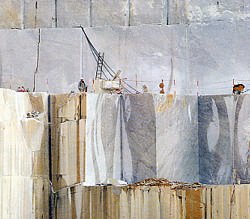
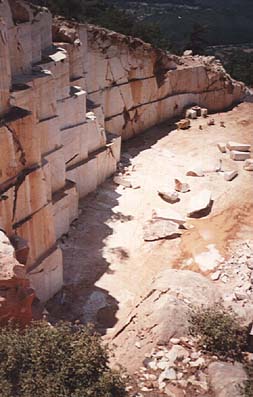
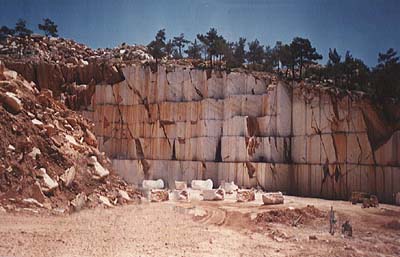
From my 29 years of experience with various phases of the stone trade, I can assist you with every step of the process, from selecting the appropriate stone material based on your decorating need, to explaining various aspects of the various types of stones which you should be aware of in making your final selection.
This includes:
Your selection of materials and consultation regarding shade variations in the stone, natural striations, oiling of slabs by the industry, and how this affects your stone, laminations for increased thickness or greater strength in necessary areas, pin holes or natural veins found in the stone, and how we deal with these in the fabrication of your material. I can offer you design advice if you need assistance. Feel free to give us a call in the Issaquah, Washington area at (425) 391-8487.
Stone Finishes include:
 A flat to low sheen gloss. Different levels of gloss can be selected. This surface is smooth, but often is very porous. This texture is common in high traffic buildings. Honed stone colors are not as vibrant as polished stone. The polishing process is halted before a reflective shiny surface is achieved, giving a matte finish to the stone. The satin surface produces relatively little light reflection. Generally, a honed finish is preferred for floors, stair treads, thresholds and other locations where the presence of water might make a polished finish slippery or where severe traffic would wear off the polished finish. Different levels of gloss can be selected. Maintenance - Seal, Dry Mop, Wet Mop, Wax
A flat to low sheen gloss. Different levels of gloss can be selected. This surface is smooth, but often is very porous. This texture is common in high traffic buildings. Honed stone colors are not as vibrant as polished stone. The polishing process is halted before a reflective shiny surface is achieved, giving a matte finish to the stone. The satin surface produces relatively little light reflection. Generally, a honed finish is preferred for floors, stair treads, thresholds and other locations where the presence of water might make a polished finish slippery or where severe traffic would wear off the polished finish. Different levels of gloss can be selected. Maintenance - Seal, Dry Mop, Wet Mop, Wax
The flamed surface is achieved by applying blow-torch strength heat to the surface of the stone. This causes the surface to melt, and some of the crystals to shatter, leaving a highly textured surface which is ideal for exterior paving, or wet areas requiring optimum non-slipperiness. Maintenance - Seal, Dry Mop, Wet Mop.
The glossy surface wears away with time due to heavy foot traffic and using improper maintenance procedures. This surface is very smooth and not very porous. The reflectivity of polished crystal brings out the brilliant colours and grains of natural stone. The shine comes from the natural reflection of the stone's crystals and is not from an artificial coating. To maintain this, we recommend resurfacing every 3 years. Or if you find that you need a stone doctor, to repair an already existing countertop or or you've purchased an antique vanity top with a chip or a blemish which you feel is a detriment and does not add to the aestetic value, but you are fond of the piece, simply give us a call, and we'll make your stone look like new. Maintenance - Seal, Dry Mop, Wet Mop, Wax
- A slightly rough texture that is achieved by tumbling small pieces of marble, limestone and sometimes granite to achieve a worn appearance.
- This surface is the result of a pressurized flow of sand and water that provides a glossy texture.
- A coarsely polished finish achieved by using a gang saw.
The difference between "honed" and "polished" granite.
"Honed" or "polished" refers to the type of finish on a slab of marble or granite. The finish of honed marble or granite will range from a flat to a low sheen gloss, which gives the stone a softer look. Polished granite refers to the glossy, highly reflective appearance, giving it a smooth, sleek look.
Rock is a hard substance composed of various minerals. The most common are those combinations of minerals forming the earth's crust. Eight elements, alone or in combination; make up 100 common minerals, but less than 20 are widely distributed in the earths crust. Quartz, Calcite, Feldspars, Micas, Augite, and Hematite make up all rocks.
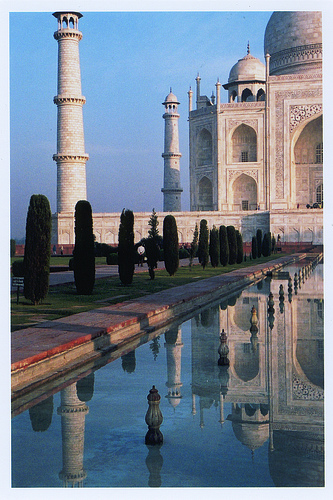
Marble is what happens to fairly pure limestone after metamorphism. Heat and pressure cause the grains of calcite in limestone to combine into larger crystals. In this hand specimen of marble, the crystals are large. For fine marble of the sort used in buildings and sculpture, the crystals are small. The color of marble can range from the purest white to black, ranging through the warmer colors in between depending on the other mineral impurities.
Known for its beauty and elegance, marble is a timeless classic. Throughout the centuries, it was the material of choice for artists and architects to create magnificent sculptures, monuments, and buildings such as the Taj Mahal in India and the Greek Parthenon. Inspired by such masterpieces of antiquity, architects and designers of today use marble to add an aura of sophistication and splendor to any space.
Marbles are comprised of calcium carbonate mineral calcite, though they contain smaller amounts of other minerals which contribute to their color. Marble is recrystallized limestone that formed when the limestone softened from heat and pressure recrystallized into marble where mineral changes occurred. The main consistency is calcium and dolmite. The color range is extensive and marble is heavily veined. Carrara, Thassos, and Bianco Rosa are considered true marbles.
Marbles often occur interbedded with such metamorphic rocks as mica schists, phyllites, gneisses, and granulites and are most common in the older layers of the Earth's crust that have been deeply buried in regions of extreme folding and igneous intrusion. The change from limestones rich in fossils into true marbles in such metamorphic regions is a common phenomenon; occasionally, as at Carrara, Italy, and at Bergen, Norway. recrystallization of the rock has not completely obliterated the organic structures. The demand for natural stone has increased at a tremendous rate in the past 20 years. The stone industry, is a major industry of many countries around the world: Brazil, Guatemala, Italy, Greece, Indonesia, Australaia, Zimbabwe, India, Spain, Mexico, South Africa, Canada, the United States. Spain is one of the largest producers of high-quality marble. It is imported to the United States for all types of building projects, and it is a very good building material. Marble was used in the building of the temple, 1 Chr. 29:2. Pillars of, Esth. 1:6; Song 5:15. Merchandise of, Rev. 18:12. Mosaics of, Esth. 1:6.
Marble does not split easily into sheets of equal size and must be mined carefully. Blocks of marble are mined with channeling machines, which cut grooves and holes in the rock. Miners outline a block of marble with rows of grooves and holes. They then drive wedges into the openings and separate the block from the surrounding rock. The blocks are cut with saws to the desired shape and size.
Marble is classified into 3 major catagories: 1) Domite: If it has more than 40% magnesian carbonate. 2) Magnesian: If it has between 5% and 40% magnesian carbonate. 3) Calcite: If it has less than 5%.
There are 3 types of rock on the surface of the earth. 1) Sedimentary or layered rock. 2) Metamorphic or changed rock. 3) Igneous or volcanic rock. Marble is of the first 2 types. Dolomitic Marble is created from the action of limestone under pressure, heat and various minerals pass through the rock during formation. The 3 major groups of Dolomitic Rock are:
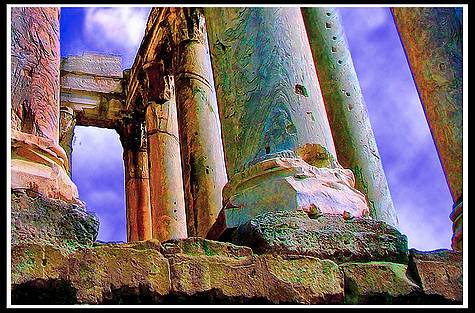
 Travertine began as limestone, and with the passing of time, through geological shifting, has found its way deep in the Earth. The porous nature of limestone makes it a reservoir for liquids. Aquifers, which are the enormous underground pools of water that feed our wells and water our cities, are the remnants of ice age melting, which sank below and was absorbed by limestone. Heated by the Earth's inner core, the water rises as steam and hot pressurized water, to form hot mud baths, "Old Faithful", " Mammoth Springs", and other gizers. This rising hot water, disolves the limestone and brings with it granules from below, forming mud beds on the surface. If enough time transpires, and the mud beds cool, they will crystallize into solid stone called travertine.
Travertine began as limestone, and with the passing of time, through geological shifting, has found its way deep in the Earth. The porous nature of limestone makes it a reservoir for liquids. Aquifers, which are the enormous underground pools of water that feed our wells and water our cities, are the remnants of ice age melting, which sank below and was absorbed by limestone. Heated by the Earth's inner core, the water rises as steam and hot pressurized water, to form hot mud baths, "Old Faithful", " Mammoth Springs", and other gizers. This rising hot water, disolves the limestone and brings with it granules from below, forming mud beds on the surface. If enough time transpires, and the mud beds cool, they will crystallize into solid stone called travertine.
Travertine is a unique stone rich with historical significance. The word travertine comes from an old Roman name for Tivoli, a town in Italy where large deposits of travertine exist. The brilliant beige stone, characterized by irregular surfaces and edges, has been a principal building material in Rome since the Roman Empire. Travertine clothed the exterior of the Colosseum and was later favored by Michelangelo for his sculptures.
Travertine is usually hard and semi-crystaline. It's frequently found to be beautifully coloured and banded as a result of the iron compounds present or other minerals. Usually a cream or reddish color. It's formed through the accumulation of calcite from geysers bursting forth from extremely hot springs of water, and underground rivers deep below the earth's surface. As the water falls and evaporates, it leaves behind the discolored limestone, which rehardens into stone. The new stone is full of gas bubbles which gives travertine it's characteristic appearance. Generally, travertine takes a higher polish than stalactite or stalagmite whose chemical composition and origin are similar. The compact crystalline variety of travertine has been used as building material since ancient Roman times.
Travertine can be cut on either a "vein" cut, which is against the bedding which reveals the bedding planes, or a "fleuri" cut, which is along the bedding plane and reveals flowery, often circular patterns. This cut is also referred to as a "crosscut" pattern.
The largest building in the world constructed mainly of travertine is the Colosseum in Rome. Another notable building using travertine extensively is the Getty Center in Los Angeles, California. The travertine used in the construction was imported from Tivoli. The website of the Getty Center contains more information about the use of travertine in its construction, including some videos of travertine being quarried and cut for use. Travertine has formed 16 huge, natural dams in a valley in Croatia known as Plitvice Lakes National Park. The stone is most widely used in Italy, Greece and Turkey, Mexico.
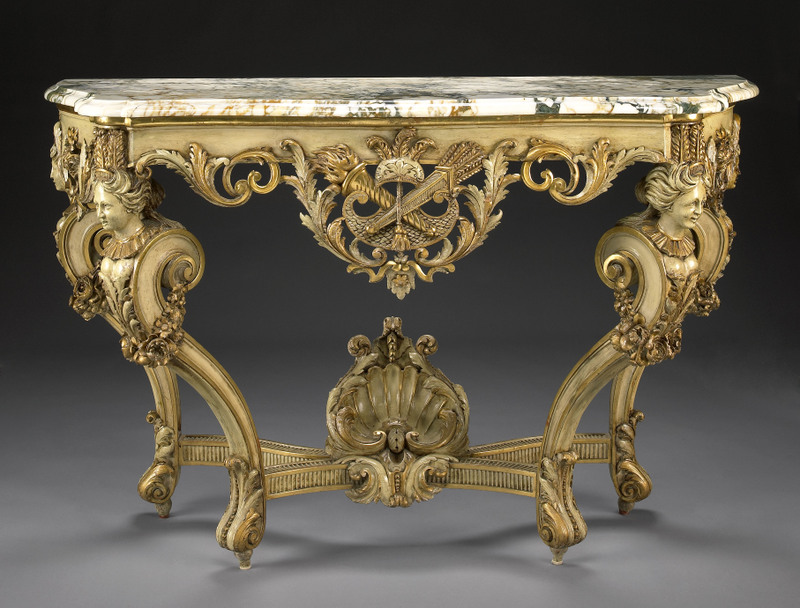 Serpentinite is California's state rock. The name Vermont is an English form of the name that French explorer Samuel de Champlain gave to Vermont's Green Mountains on his 1647 map. He called them "Verd Mont" meaning green mountain. Currently, this nickname is displayed on Vermont license plates.This 1-1/2 meter serpentinite boulder sits in a place of honor in the roof garden of the Oakland Museum of California, its polished surface gleaming blue and jade-green.
Serpentinite is California's state rock. The name Vermont is an English form of the name that French explorer Samuel de Champlain gave to Vermont's Green Mountains on his 1647 map. He called them "Verd Mont" meaning green mountain. Currently, this nickname is displayed on Vermont license plates.This 1-1/2 meter serpentinite boulder sits in a place of honor in the roof garden of the Oakland Museum of California, its polished surface gleaming blue and jade-green.
Serpentine is said to owe its name either to its serpent-like colours and patterns or from an old belief that the stones were effective protection from snake bites. The colors are predominently green and brown, with shading looks like the marks on a serpent. These seafloor rocks were kneaded by both the horizontal compression due to subduction and the horizontal elongation due to movement along the San Andreas fault system. The Franciscan Complex is what resulted, a challenging problem for generations of western geologists. Only with the advent of plate tectonics did the story of this rock become clear.
They have their origins in metamorphic alterations of peridotite and pyroxene. Serpentines may also pseudomorphously replace other magnesium silicates. Alterations may be incomplete, causing physical properties of serpentines to vary widely. Where they form a significant part of the land surface, the soil is unusually high in clay. Most serpentines are opaque to translucent, light (specific gravity between 2.2–2.9), soft (hardness 2.5–4), infusible and susceptible to acids. All are microcrystalline and massive in habit, never being found as single crystals. May be vitreous, greasy or silky. Colours range from white to grey, yellow to green, and brown to black, and are often splotchy or veined. Many are intergrown with other minerals, such as calcite and dolomite. Occurrence is worldwide; New Caledonia, Canada (Quebec), USA (northern California), Afghanistan, Cornwall, China, France, Norway and Italy are notable localities.
Rock composed primarily of these minerals is called serpentinite. Serpentines find use in industry for a number of purposes, such as railway ballasts, building materials, and the asbestiform types find use as thermal and electrical insulation (chrysotile asbestos). The more attractive and durable varieties (all of antigorite) are termed "noble" or "precious" serpentine and are used extensively as gems and in ornamental carvings. Often dyed, they may imitate jade. Misleading synonyms for this material include "Korean jade", "Suzhou jade", "Styrian jade", and "New jade". New Caledonian serpentine is particularly rich in nickel, and is the source of most of the world's nickel ore.
Polished slab of bowenite serpentine, a variety of antigorite. Typical cloudy patches and veining are apparent.The Mâori of New Zealand once carved beautiful objects from local serpentine, which they called tangiwai, meaning "tears". Material quarried in Afghanistan, known as sang-i-yashm, has been used for generations. It is easily carved, taking a good polish, and is said to have a pleasingly greasy feel.
The lapis atracius of the Romans, now known as verde antique or verde antico, is a serpentinite breccia popular as a decorative facing stone. In classical times it was mined at Casambala, Thessaly, Greece. Serpentinite marbles are also widely used: Green Connemara marble (or Irish green marble) from Connemara, Ireland (and many other sources), and red Rosso di Levanto marble from Italy. Use is limited to indoor settings as serpentinites do not weather well.
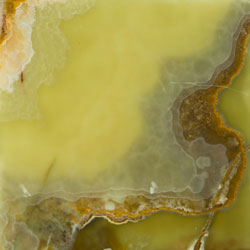 Onyx is formed by quartz crystals which are fused together by nature into translucent layers of stone, revealing a rainbow of colors ranging Form creamy whites, gold’s and ambers to orange, reds, browns deep greens, and grays. The natural process of heat and pressure creates a crystalline stone rich in color and pattern that reaches well below the surface to reveal a truly unparalleled inner warmth, depth and opalescence.
Onyx is formed by quartz crystals which are fused together by nature into translucent layers of stone, revealing a rainbow of colors ranging Form creamy whites, gold’s and ambers to orange, reds, browns deep greens, and grays. The natural process of heat and pressure creates a crystalline stone rich in color and pattern that reaches well below the surface to reveal a truly unparalleled inner warmth, depth and opalescence.
Onyx, like travertine, is the result of water dissolving existing limestone and re-depositing it as a new kind of stone, sometimes called sinter. In limestone caves, onyx is formed by drip water, as stalagmites and stalactites. It's a very soft stone, and somewhat brittle, and needs to be installed where it will not be subject to hard wear. This beautiful stone is characterized by its translucence, and can actually be backlit for striking, dramatic effects.
Onyx is quartz crystals fused together by nature into translucent layers of stone, revealing a rainbow of colors ranging Form creamy whites, gold's and ambers to orange, reds, browns deep greens, and grays. Onyx is not a new stone; It is actually millions of year old! A natural process of heat and pressure creates a crystalline stone rich in color and pattern that reaches well below the surface to reveal a truly unparalleled inner warmth, depth and opalescence.
The name Onyx is derived from the Greek term meaning the nail of a finger. It's a member of the chalcedony family which includes carnelian, agate, etc. Occurring naturally in a variety of colours, black onyx is polished to enhance it's appearance, a member of the quartz family. Originally, almost all colours of chalcedony from white to dark brown and black were referred to as onyx. Today we tend to think of onyx as black. A variety of onyx which is reddish brown with white and lighter red bands is called sardonyx.
Similar to limestone, onyx is a softer stone best placed where it won't be used or abused on a day to day basis. It is porous and needs to be sealed. Otherwise, it will absorb water and liquids easily which tend to stain the stone. Once a stain is absorbed into onyx, it is extremely hard to remove.
Onyx marble is most often used as a fireplace surround, bar top, or as a small island because it transmits light.
Heb. shhm; Sept. onychion; Vulg. lapis onychinus; the eleventh stone of the breastplate in the Hebrew and the Vulgate (Exodus 28:20; 39:13), representing the tribe of Joseph. The Vulgate indeed gives onyx as the equivalent of the Hebrew shhm. Stronger evidences are in the fact that the Hebrew word occurs frequently in scripture. (Genesis 2:12; Exodus 25:7; 25:9, 27; 1 Chronicles 29:2; etc.) and on each occasion, but Job, xxviii, 16, it is translated in the Vulgate by lapis onychinus (lapis sardonychus in Job 28:16). The Greek is very inconsistent in its translation, rendering shhs differently in various texts; thus in Gen., ii, 12, it is lithos prasinos, sardios in Ex. xxv, 7; v, 9; smaragdos in Ex., xxviii, 9; v, 27; ix, 6; soam, a mere transcription of the Hebrew word in I Par., xxix, 2; and onyx in Job, xxviii, 16. Onyx is the stone signified by shhm. The onyx is a variety of quartz analogous to the agate and other crypto-crystalline species. It is composed of different layers of variously coloured carnelian much like banded agate in structure, but the layers are in even or parallel planes. Hence it is well adapted for the cutting of cameos and was much used for that purpose by the ancients. The colours of the best are perfectly well defined, and are either white and black, or white, brown, and black. The best specimens are brought from India. Sardonyx has a structure like onyx, but is composed usually of alternate layers of white chalcedony and carnelian, although the carnelian may be associated with layers of white, brown, and black chalcedony. The ancients obtained the onyx from Arabia, Egypt, and India.
LIMESTONE
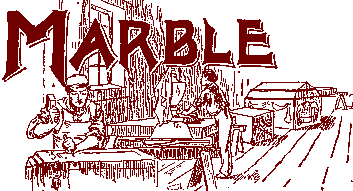 Limestone is formed near hotsprings and colours can range from creamy whites to browns and blacks which impart warmth and subtlety to any structure. It's mainly sedimentary rock consisting of organic material such as tiny grains of sand, skeletons, and shells of marine life, and other sediments, which form ooliths around which calcium carbonate adheres. All limestones originated as sea-floors of tropical regions of the world, and there are limestones which are in process in this way at the present time. Seawater contains carbon dioxide (C0 2) which escapes when warmed by the sun. As this takes place, calcium and bicarbonate ions in the water combine to form calcium carbonate, like scales form inside a kettle.
Limestone is formed near hotsprings and colours can range from creamy whites to browns and blacks which impart warmth and subtlety to any structure. It's mainly sedimentary rock consisting of organic material such as tiny grains of sand, skeletons, and shells of marine life, and other sediments, which form ooliths around which calcium carbonate adheres. All limestones originated as sea-floors of tropical regions of the world, and there are limestones which are in process in this way at the present time. Seawater contains carbon dioxide (C0 2) which escapes when warmed by the sun. As this takes place, calcium and bicarbonate ions in the water combine to form calcium carbonate, like scales form inside a kettle.
Limestone contains calcite. It does not show much graining or crystalline structure. It has a smoothe granular surface. It varies in hardness. Some dense limestone can be polished. There are limestones called Beauharnais (Bow-Are-NAY) which are very hard and dense. Limestone is known to contain lime from seawater. It comes in black, gray, white, yellow and brown. Finishes include polished, honed and tumbled. All limestone however, is still calcium based, so susceptible to stains.
The shelly limestones of the Purbeck Beds, Eng., and the ussex marble, both of Mesozoic Era (from 65,000,000 to 225,000,000 years ago), consist of masses of shells of freshwater snails embedded in blue, gray, or greenish limestone. They were a favourite material of medieval architects and may be seen in Westminster Abbey and a number of English cathedrals. Limestone was a very popular building block in the middle ages in the areas where it occurred since it is hard, durable, and commonly occurs in easily accessible surface exposures. Many medieval churches and castles in Europe are made of limestone. Black limestones containing bituminous matter, which commonly emit a fetid odour when struck, are widely used; the well-known petit granit of Belgium is a black marble containing crinoid stem plates, derived from fossil echinoderms (invertebrate marine animals).
Limestone is especially popular in architecture, and many landmarks around the world, such as Israel. It's abunsant in North America and Europe, are made primarily of the material. So many buildings in Kingston, Ontario, Canada were constructed from it, that it was nicknamed the 'Limestone City'. Limestone is readily available and relatively easy to cut into blocks or more elaborate carving. It is also long-lasting and stands up well to exposure. However, it is a very heavy material, making it impractical for tall buildings. It is also quite expensive. Limestone was most popular in the early 20th and late 19th centuries. Train stations, banks and other structures from that era are normally limestone. Limestone is used as a facade on some skyscrapers, but only in thin plates for covering rather than solid blocks. In the United States, Indiana has long been noted as a source of high quality quarried building Indiana limestone, while many famous buildings in London are built from Portland limestone. Limestone was most popular in the late 19th and early 20th centuries — train stations, banks and other structures from that era are often limestone. It is used as a facade on some skyscrapers, but only as thin cladding rather than solid structural blocks.
SANDSTONE
Sandstone can be found in abundance in Israel. At Beersheba, sandstone blocks integrated into the walls of the storehouses were originally part of a four-horned altar. Three of the sandstone blocks preserved the shape of large horns typical of four-horned altars, while a fourth showed evidence that the horn had been broken off. Another of the stones bore the image of a deeply incised serpent.
The historic section of the capital city of Berne, listed as a cultural heritage project, is almost entirely built of locally Bernese Sandstone. The sandstone deposits in India are primarily found in Rajasthan - the only place in India with extensive deposits. The districts of Karauli, Dholpur and Bharatpur on the east, Kota, Bundi, Bhilwara and Chittorgarh on the south, and Nagaur and Jodhpur on the west of Jaipur are the most promising ones. The extension of deposits can be seen on the map. Shivpuri and Lalitpur in Madhya Pradesh also have some deposits of sandstone. Lemon Tint Mint and Lalitpur Yellow are being exported in different sizes and thicknesses.
Sandstone can be used for such projects as
If the magma cools and hardens inside the earth, it is called "intrusive" rock. This rock cools slowly and has large crystals. When the magma does not reach the earth's surface, it is formed into a variety of geological structures. This intrusive type of stone is what is typically used as building stone. It is quarried from beneath the earth's surface and it comes in a variety of types, such as granite, basalt and obsidian.
Most granite intrusions are emplaced at depth within the crust, usually greater than 1.5 kilometres and up to 50km depth within thick continental crust. It is very hard, crystalline. When the molten material forming the earth's core (magma) comes up from just beneath the earth's surface, it cools, forming the crystalline granular structure called "Granite." It is primarily made of quartz (35%) feldspar (45%) and potassium. The differences in the color of granite are due to the percentage of quartz, mica and feldspar. The Vosges, though not the highest elevations, are composed of granite, exhibiting no vestige of marine products, and these granites are not covered with calcareous beds, although the sea has borne its relics to much greater heights in other places. With this exception, it is only in high vitreous mountains that the ancient structure and primitive composition of the earth can be seen bare in masses of quartz, veins of jasper, groups of granite, and metallic veins. Various placements of minerals form the pattern of granite.
Granite contains little calcite. Provides a heavy crystalline and granular appearances with mineral grains and can be polished to a high shine. The stone comes in a variety of colors ranging from salt and pepper to reddish brown and black. Due to the extreme hardness and density of granite, it accepts a long lasting polish. It's is the hardest building material, has high load bearing capability, is resistant to chemical erosion, with it's durability makes it resistant to weathering, yet capable of taking a mirror polish. It comes in facinating colours, and testural patterns, making it an excellent choice for kitchen counter tops, custom made furniture such as table tops, desks or garden furniture, bathroom vanities, and fireplace surrounds. India is one of the leading producers of slab granite and granite tile. Major granite producing regions are the Scandinavian Peninsula (mostly in Finland and Norway), Spain ( mostly in the Galicia area), Brazil, India and several countries in the South end of the African continent, namely Angola, Namibia, Zimbabwe and South Africa. Historic applications of this stone: The Red Pyramid of Ancient Egypt (c.26th century BC), named for the light crimson hue of its exposed granite surfaces, is the third largest of Egyptian pyramids. Menkaure's Pyramid, likely dating to the same era, was constructed of limestone and granite blocks. The Great Pyramid of Giza (c.2580 BC) contains a huge granite sarcophagus fashioned of "Red Aswan Granite." The mostly ruined Black Pyramid dating from the reign of Amenemhat III once had a polished granite pyramidion or capstone, now on display in the main hall of the Egyptian Museum in Cairo (see Dahshur). Other uses in Ancient Egypt, include columns, door lintels, sills, jambs, and wall and floor veneer.
A distinctive pink granite forms most of Pikes Peak, Colorado. Its major constituent is pink-orange potassium feldspar. The gray, clear mineral is quartz, which is diagnostic of granite—that is, a rock without quartz, no matter what else is in it, cannot be called granite. There are also a few rare white grains of plagioclase feldspar, and also a darker mineral, the brown mica phlogopite. As old as the earth itself, granite is one of the hardest and durable of all building stones. Syene Opening (Eze 29:10; Eze 30:6), a town of Egypt, on the borders of Ethiopia, now called Assouan, on the right bank of the Nile, notable for its quarries of beautiful red granite called "syenite." It was the frontier town of Egypt in the south, as Migdol was in the north-east.
The obelisk of Hatshepsut, built in the year 1457 BC, during the XVIII dynasty, is the second biggest of all the ancient Egyptian obelisks. Made of one single piece of pink granite, it has a height of 28.58 metres and its weight is 343 tons. It is located in the Big Temple of Amon, in Karnak.
ALABASTER
"Alabaster is a beautiful and varied stone prized by sculptors worldwide since the beginning of recorded history. It has been deposited in nature in an incredible rainbow of colors. It can be translucent as in the variety Selenite or nearly opaque, transmitting little light. The translucent stone is quarried either in open pits or underground. In open pits, veins of Alabaster are found 12 to 20 feet below the surface under a layer of shale which can be two or three feet deep. The rocks have an average height of 16-20 inches and a diameter of two to three feet. Rarely do the rocks exceed these sizes.
The term "alabaster" occurs in the New Testament only in the notice of the alabaster box of ointment which a woman brought to our Lord when he sat at meat in the house of Simon the leper at Bethany. She poured the contents on the head of Jesus (Matthew 26:7; Mark 14:3; Luke 7:37).
This Bas-relief is a photo showing the gods Isis and Osiris, Ptolemaic period, Ancient Egypt, 323-30 BCA. Alabaster is found throughout the histories of Sumer, Babylon and Assyria and of course, Mexico and Egypt. Deposits of alabaster are not only found in Egypt also in countries like Algeria, England, United States, Belgium, India, Turkey, Spain, Cyprus, and Italy.
Usually describes the mineral Gypsum, especially the varieties that are compact, take a good polish, and often have some degree of translucency. This term has occasionally been applied to some types of very pure, fine grained and semi-translucent Marbles such as much of the stone used in ancient Egypt for both functional and decorative objects. Cosmetic jars made of this are intricately carved, and the bible contains a story of a woman who possessed a perfume vial of this sort.
SOAPSTONE
CARE & USE FOR YOUR STONE COUNTERTOP
THE PROFESSIONAL MAINTENANCE PROGRAM FOR YOUR NATURAL STONE
The sealer will penetrate below the stone's surface without leaving a coating or film on top. The stone below the surface will be protected, however, there is no surface protection. This means calcareous natural stones such as marble, onyx, limestone, and travertine can still etch or dull if acidic products such as orange juice or coke are left on your stone.
To help provide surface protection, a natural vegetable soap cleanser or a cleanser made specifically for natural stone should be used. These cleansers build up a thin film layer between periodic deep cleanings. Natural vegetable soaps and stone cleaners remove dirt and debris from the stone's surface the same as a detergent soap does. They are just milder.
Etching is the result of a chemical reaction occuring when acid comes in contact with a surface. Etch marks on stone surfaces resemble water spots or a worn polish.
Items like orange juice, coffee, vinegar, wine, tomato products, mustard, and many soft drinks are highly acidic and will etch, discolor, or even scratch most marble, limestone, and travertine (acid resistant stones like most granite, slate, and sandstone will typically not etch). Sealing will give you time to clean up a spill, but cannot stop the chemical reaction that may leave a dull mark. Professional refinishing is the best way to remove etch marks and restore your natural stone’s even finish.
THE UNIQUE FACETS OF USING NATURAL STONE
NATURAL STONE FOR OUTDOOR APPLICATIONS
In your garden, practically any natural stone can be used. Granite pathways are popular, especially when complemented with granite lanterns or Japanese basins and sculptures. If you like marble, you could utilize such custom made items as stone marble fountains, flowerboxes in marble, plant stands, garden benches or sculptures for an elegant effect. Limestone pathways in earthtone hues add a touch of class, or you could try slate flagging. Garden walls may be done in slate slabs for a unique decorating texture on a patio. You could design an outdoor kitchen with a barbecue area using natural stone on the walls and floors as a backdrop.
Travertine and slate look very attractive outdoors, with slate around the pool area and the driveway. But nothing looks quite as imposing and distinguished as a nameplate in polished granite, particularly black granite.
TERRAZZO FOR INDOOR & OUTDOOR USE
As far back as the Roman days, Terrazzo floors were installed in prestigious buildings when Terrazzo was used by Roman architects to add beauty and variety to the courtyards and villas of their patrons. The Romans adapted mosaic to create linear borders of repeating patterns, such as egg and dart, acanthus leaf, and Greek key designs. The earliest illustration of the fabrication of a terrazzo floor is found in Della Architettura by Giovanni Antonio Rusconi, in which wood carvings date back to the sixteenth century. By the end of the sixteenth century, a Guild of Terrazzo workers was granted it's statute, it's techniques having already become well established. Giobatta Crovato was one of the early founders of this guild of craftsmen. Terrazzo reached a zenith of splendor and developement in Venice, where it came to be known as Venetian Terrazzo. In Venice, where mosaic never went out of style, 15th century mosaic workers used leftover marble chips to surface the terraces of their own living quarters. Giandomenico Facchina, from Sequals is buried in Paris at Pere Lachaise, a cemetery for artists, because he created some of the most beautiful works of art. Terrazzo can be found in Ancient Greece.
The term, from the Italian word for terraces, was created several hundred years ago in Europe when Venetian workers discovered a new use for discarded marble remnants. Since that time it has become a logical, practical solution for contemporary design and construction.
While it is widely believed that terrazzo was developed by the Venetians, archeologists have found evidence of terrazzo floors in ruins in Turkey that may be as many as 8,000 to 10,000 years old. In 7,000 BC or earlier at Cayonu, at the foot of the Taurus Mountains, near Bogazcay, a tributary of the Tigris River, smelted copper Terrazzo floors have been found.
The first terrazzo floors were made of marble chips set into clay, and sealed with goat’s milk to produce a high gloss finish. Later floors, taking advantage of technological advances in the 1920s used a three step process to make the floor design.
Fifteenth-century Venetian mosaic workers began to use odd-size marble chips (remaining from shaping the stone tesserae) to surface the terraces around their living quarters. The uneven surfaces created, when the chips were set in clay to anchor them, convinced the workers that flattening the surface would produce a smoother surface more comfortable for walking. They began to rub the surface with handstone, achieving a flat surface.
In the late 1700s, Europeans brought terrazzo with them to America, when highly skilled craftsmen were hired to install the unique material. Often the preferred flooring material in government buildings, churches, hospitals and libraries, for centuries it has been equally popular with residential owners. The basic construction techniques and appearance of terrazzo remain unchanged, resulting in a smoothe, dense and highly polished surface, which is then sealed to retain it's polished appearance.
Terrazzo has been used extensively in monumental structures. (Our first President, George Washington, designed his Mt. Vernon home and selected Terrazzo for many of the rooms.)
Today, for those with an appreciation for both the old world elegance as well as the durability of fine ancient european craftmanship, terrazzo floors are being used in up scale office buildings,airports, hospitals, schools and increasingly in homes.
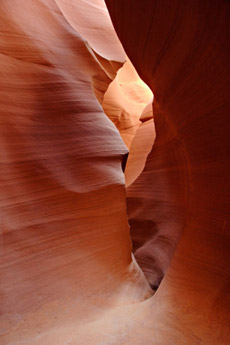 Sandstone rocks are sedimentary rocks made from small grains of the minerals quartz, which is the main ingredient, but is accompanied by mica, feldspar and other minerals. Most sandstone is formed in oceans, lakes, and rivers where tiny bits of rock and dirt settle to the bottom. Year after year, these layers of sand are continually buried under tons of more sand and dirt until it's turned to solid rock. The chemical constitution is that of sand, the rock is thus composed of essentially quartz. Grains may be cemented by silica, calcite, or iron oxides. Sandstone often forms in layers, with fossils embedded in the layers. They are often used as building stones. Sandstone is often marked with the ripples of an ancient sea bed. It can be found in many colours which range from red, brown, greenish, yellow, grey, and white.
Sandstone rocks are sedimentary rocks made from small grains of the minerals quartz, which is the main ingredient, but is accompanied by mica, feldspar and other minerals. Most sandstone is formed in oceans, lakes, and rivers where tiny bits of rock and dirt settle to the bottom. Year after year, these layers of sand are continually buried under tons of more sand and dirt until it's turned to solid rock. The chemical constitution is that of sand, the rock is thus composed of essentially quartz. Grains may be cemented by silica, calcite, or iron oxides. Sandstone often forms in layers, with fossils embedded in the layers. They are often used as building stones. Sandstone is often marked with the ripples of an ancient sea bed. It can be found in many colours which range from red, brown, greenish, yellow, grey, and white.
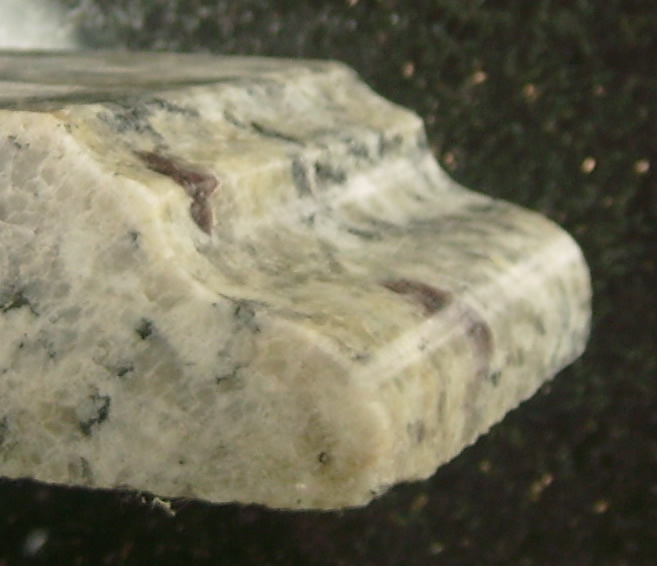 The term "granite" means "grain" in Latin, and is derived from "Granum" because of it's granular nature. Granite is volcanic rock, called igneous rock. Granite is formed from magma. Granite magma has many potential origins but it must intrude other rocks. Granite magma must make room for itself or be intruded into other rocks in order to form an intrusion, and several mechanisms have been proposed to explain how large batholiths have been emplaced. When the magma comes out of the earth's crust through a volcano as lava and is exposed to the surface elements, it cools and hardens, producing the more porous and less dense stones, such as pumice. This type of igneous stone is called "extrusive."
The term "granite" means "grain" in Latin, and is derived from "Granum" because of it's granular nature. Granite is volcanic rock, called igneous rock. Granite is formed from magma. Granite magma has many potential origins but it must intrude other rocks. Granite magma must make room for itself or be intruded into other rocks in order to form an intrusion, and several mechanisms have been proposed to explain how large batholiths have been emplaced. When the magma comes out of the earth's crust through a volcano as lava and is exposed to the surface elements, it cools and hardens, producing the more porous and less dense stones, such as pumice. This type of igneous stone is called "extrusive."
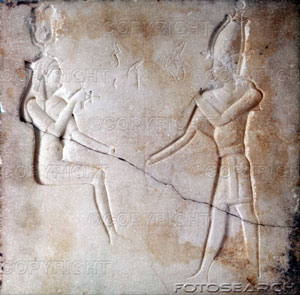 This type of natural material is defined as fine-grained, massive gypsum (q.v.) that has been used for centuries for statuary, carvings, and other ornaments. It normally is snow-white and translucent but can be artificially dyed; it may be made opaque and similar in appearance to marble by heat treatment. Florence, Livorno, and Milan, in Italy, and Berlin are important centres of the alabaster trade.
This type of natural material is defined as fine-grained, massive gypsum (q.v.) that has been used for centuries for statuary, carvings, and other ornaments. It normally is snow-white and translucent but can be artificially dyed; it may be made opaque and similar in appearance to marble by heat treatment. Florence, Livorno, and Milan, in Italy, and Berlin are important centres of the alabaster trade.In the days just prior to His crucifixion, a woman at Bethany (see The Place Of Christ's Ascension And Return) anointed Jesus Christ with the contents of an alabaster flask. (Luke 7:36-50)
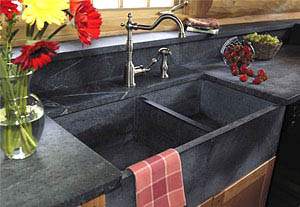 Soapstone is a metamorphic rock mainly composed of quartz and muscovite, along with other minerals. It can be made into roofing slates (shingles) because of its clevage and grain, two lines of breakability that make it possible to split into thin sheets. It is composed of talc, magnesium silicate and chlorite. The softer is known as "talc" and is used to carve or crush to a powder for a variety of purposes. It is a quarried stone that comes in shades such as green/gray, blue/gray and charcoal gray in its natural state but turns quite dark to almost black with the application of mineral oil. In the 18th and 19th centuries, slate was used for blackboards and individual writing slates. More recently, it has been used for laboratory bench tops and billiard table tops due to it's thermal stability and chemical inertness. Soapstone occurs in many metamorphic terranes throughout the world. Two well-known sources of soapstone used for carvings (etc.) are the Limbue quarries, near Lake Nyasa, Malawi (formerly Nyasaland) and quarries near Kundla, Gujarat State, ay Province, India. Soapstone for Canadian Eskimo carvings has come from the Yukon Territory and Baffin Island. In the western United States, perhaps the best known source of soapstone used for carvings (etc.) is Skagit County, Washington. Quarries near Schulyer, Nelson County, Virginia, which have been a good source of soapstone used for such things as griddles and acid-resistant counter tops and sinks, would appear to constitute a potential source of carving material.
Soapstone is a metamorphic rock mainly composed of quartz and muscovite, along with other minerals. It can be made into roofing slates (shingles) because of its clevage and grain, two lines of breakability that make it possible to split into thin sheets. It is composed of talc, magnesium silicate and chlorite. The softer is known as "talc" and is used to carve or crush to a powder for a variety of purposes. It is a quarried stone that comes in shades such as green/gray, blue/gray and charcoal gray in its natural state but turns quite dark to almost black with the application of mineral oil. In the 18th and 19th centuries, slate was used for blackboards and individual writing slates. More recently, it has been used for laboratory bench tops and billiard table tops due to it's thermal stability and chemical inertness. Soapstone occurs in many metamorphic terranes throughout the world. Two well-known sources of soapstone used for carvings (etc.) are the Limbue quarries, near Lake Nyasa, Malawi (formerly Nyasaland) and quarries near Kundla, Gujarat State, ay Province, India. Soapstone for Canadian Eskimo carvings has come from the Yukon Territory and Baffin Island. In the western United States, perhaps the best known source of soapstone used for carvings (etc.) is Skagit County, Washington. Quarries near Schulyer, Nelson County, Virginia, which have been a good source of soapstone used for such things as griddles and acid-resistant counter tops and sinks, would appear to constitute a potential source of carving material.
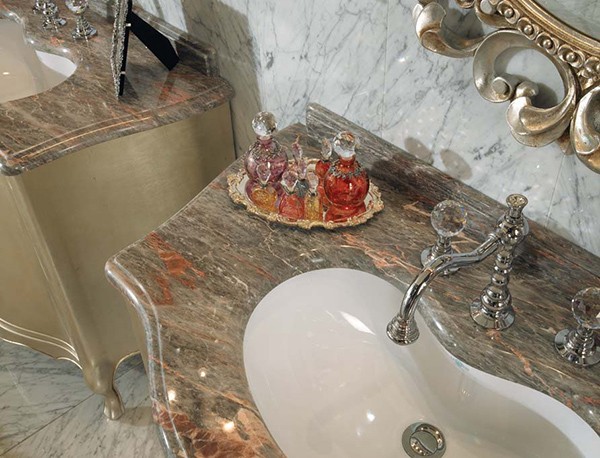
Sealing granite and natural stone with penetrating sealers, (also called impregnators), protects the structure of a natural stone. They protect the
stone from within. When sealing natural stone or granite with this type of sealer, it is applied directly to the face of the stone with a soft cloth. It's simple to do and does not require a stone specialist. This type of sealer is recommended for sealing granite.
 Terrazzo is a composite consisting of chips of marble, granite, glass and other stones. The Egyptians were actually the first to hand set pieces of stone, glass or ceramics in a mortar bed to create a decorative pattern.
Terrazzo is a composite consisting of chips of marble, granite, glass and other stones. The Egyptians were actually the first to hand set pieces of stone, glass or ceramics in a mortar bed to create a decorative pattern.  Over the years terrazzo has continued to be the flooring of choice for people concerned with beauty, longevity and ease of maintenance. These floors are almost impenetrable to moisture and very durable. During the Renaissance Michelangelo used terrazzo floors in St Peter's Basilica. Terrazzo
speaks of the grandeur of elaborate stucco work, frescoes and antique terrazzo floors. Yet it is also the perfect choice for outdoor applications such as garden walls and furniture, stairways, as well as exquisitely designed mosaic terraces, with intricate inlaid marble borders.
Over the years terrazzo has continued to be the flooring of choice for people concerned with beauty, longevity and ease of maintenance. These floors are almost impenetrable to moisture and very durable. During the Renaissance Michelangelo used terrazzo floors in St Peter's Basilica. Terrazzo
speaks of the grandeur of elaborate stucco work, frescoes and antique terrazzo floors. Yet it is also the perfect choice for outdoor applications such as garden walls and furniture, stairways, as well as exquisitely designed mosaic terraces, with intricate inlaid marble borders.
Tom Campbell Journeyman Stone Craftsman-Seattle/Bellevue & Surrounding areas
Telephone (425) 252-2981
Tom Campbell is married to Alana Campbell, an artist in oils, watercolour, acrylic, pen and ink and mixed media. They have 3 sons and 3 daughters. See: Simchas
The Sanctified Imagination
Rembrandt Harmenszoon (son of Harmen) van Rijn
Johannes Vermeer
Pierre Auguste Renoir
Claude Monet: Impressionist PainterFree Illustrations
2Ki 12:12-And to masons, and hewers of stone, and to buy timber and hewed stone to repair the breaches of the house of the LORD, and for all that was laid out for the house to repair it.
Isa 58:12-And they that shall be of thee shall build the old waste places: thou shalt raise up the foundations of many generations; and thou shalt be called, The repairer of the breach, The restorer of paths to dwell in.
LINKS
